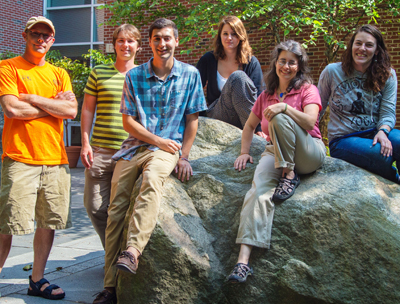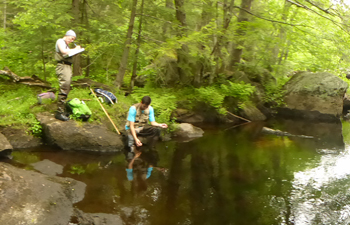Students Conduct EPSCoR Research on Natural Dams

Assistant Professor of Environmental Studies Denise Burchsted and her students are carrying out research on beaver ponds and natural dams in local waterways, as part of the research at Keene State funded by a grant from the National Science Foundation’s Experimental Program to Stimulate Competitive Research (EPSCoR). The project, entitled “Natural dams and biogeochemistry at the river network scale: implications for water quality,” is part of a larger statewide EPSCoR effort called “Ecosystems and Society”, which supports the training of researchers through the study of New Hampshire’s natural resources so the state can move forward in a sustainable fashion while maintaining our quality of life.
There are a lot of aspects to the statewide research. “They’re trying to work on the larger questions of ‘How ecosystems respond to societal pressures, and what services does society demand from those ecosystems?’” Dr. Burchsted explained. “There’s been a lot of funding put towards installing physical sensors across the state to monitor environmental factors. It’s a very technical way of addressing the changing climate.” The things the study monitors are primarily physical: such indicators as rainfall, water temperature, nitrogen levels, snowfall and snowpack, and soil properties, as opposed to collecting data on plants or animals.
While the state-wide project encompasses many ecosystems, Dr. Burchsted is doing her research as part of the group studying rivers. She is focusing on beaver dams and other natural obstructions in rivers and streams in New Hampshire, especially in the Monadnock Region, to collect information on such things as water quality and flooding. “I’m here to do my research and to train student researchers,” she said. “I have a team of undergrads who are on the ground, collecting data, which is good for me and the science, but it’s also giving them good training and helping them build their professional networks.”

“This is a great educational opportunity,” said Josh Dallesander, an environmental studies major. “I’m doing real work in the field, learning how to collect data.”
“My project ties in with the state-wide research by addressing some of the problems that we see in the modeling of river water quality,” Dr. Burchsted said. “Right now, the modeling component has a lot of trouble dealing with nutrient budgets—nutrients in the water that feed plants and algae, the things that turn water green.” If there aren’t enough nutrients, aquatic life is poor. If there are too many nutrients, such as when there are too many farms or people using lawn fertilizer, or sewage treatment plants on a watershed, some organisms—algae for example—grow too prolifically and choke out other important organisms.
Beaver dams—one of Dr. Burchsted’s special areas of study—are particularly good at stabilizing nutrients in the water. “In systems that are already enriched—where there are too many nutrients above what would normally be there, the beaver ponds will remove those nutrients from the water,” she explained. “They take the nitrogen out of the water and return it to the atmosphere.” And when the water lacks nutrients, the dams will do something about that, too. In New Hampshire, most of our water systems are nutrient poor, except those close to human activity. So a beaver dam can add nutrients to a nutrient-poor stream. When the beavers create the dam, it floods the forest floor, which picks up a lot of nutrients from the rich topsoil that’s now underwater. The beaver activity, including the sticks and trees they bring into the dam, also adds nutrients.
“Though my research ties in with the state project through the focus on nutrients, I’m really exploring the physical in-stream processes as a whole,” Dr. Burchsted said. “We’re looking at some of the simple parts of the stream that can be monitored to track what it’s processing: things like nutrients, the amount of oxygen, the pH, the temperature, and the conductivity.”
The sensors that Dr. Burchsted and her researchers have placed in the streams will help them collect data as the project goes on, so they can monitor how things change over time. “The most inexpensive indicators I have of tracking change over time is temperature and conductivity. Think of electrical conductivity like salinity—the more salt in the water, the easier it is for electricity to pass through it. In our area, the biggest source of conductivity is road salt runoff, so this is a really good tool for tracking human road management. But, in streams that aren’t near roads, it’s also a good way to track other material that comes from the soil. We can watch how rainfall mixes in with the water, because the rainfall is very dilute.” These tools are used to understand the path that water follows before it enters the rivers, which affects the quality and quantity of the water in rivers and in groundwater. “This is important for our food, drinking water supply, and flood control.”
Her students are learning valuable lessons about conducting field research and collecting data, and of the intricate web that is our environment; how unexpected or less obvious factors—both natural and man-made—can have a profound effect on the quality of our food and water. It’s a critical part of their education, but it’s also critical information for those of us who drink and use the water and eat the food that comes from our soil and water.
Support for the NH EPSCoR Program is provided by the National Science Foundation’s Research Infrastructure Improvement Award # EPS 1101245. During the first three years of the five-year Ecosystems and Society project, Keene State College has been awarded $189,625 and has committed $78,792 in cost share.





